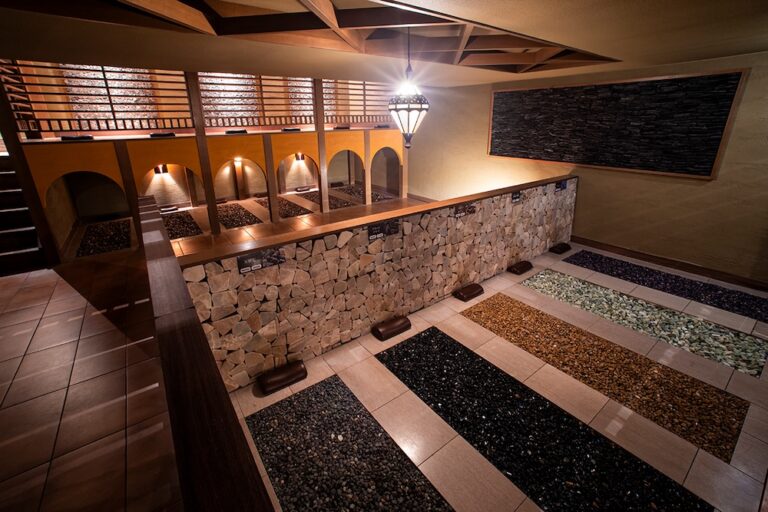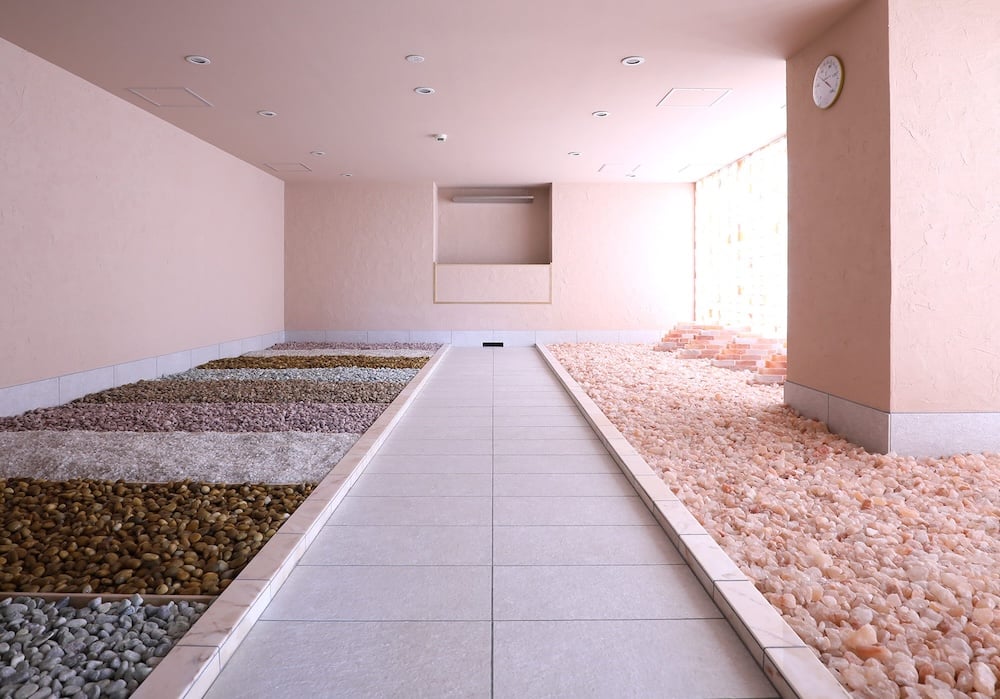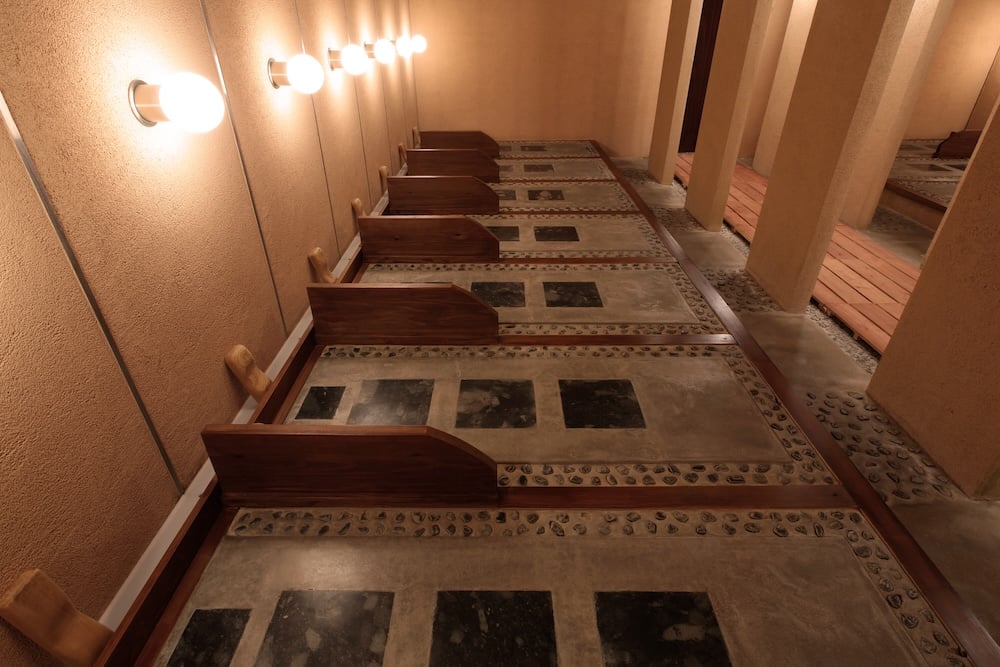
Many people planning on visiting or living in Japan have come across the concept of onsen (温泉), or natural hot springs, as a popular way to relax. But, these same people may overlook another form of relaxation and detoxification called ganbanyoku (岩盤浴). Ganbanyoku are hot stone baths, and while similar in some ways to, for example, the dry saunas of Scandinavia, they have some differences.

What is it?
The premise of ganbanyoku is fairly straightforward: patrons are given a set of clean, loose-fitting clothes and a towel; unlike onsen, ganbanyoku is done clothed! In cycles of about 15 minutes, patrons rotate around rooms set to increasingly hot and sometimes humid temperatures. Each room has a heated stone slab floor that emits infrared rays which are beneficial for the body. People lie on these stone slabs and focus on their breathing. These rooms can range from 30 to as high as 60°C (86-140°F). Usually, however, the most time is spent in the 30-40 degree range. Most people only last two to three minutes in the hottest rooms anyway. A 15-minute cycle is finished off with a cool-down in a room set to around 10-15°C. This cycle is repeated about three to four times. The goal is to relax, not push yourself to your limits, so breaks to rehydrate are encouraged as needed.
It should be noted, however, that hot stone bathing is not recommended for those with high blood pressure, who are currently sick, or pregnant. On the other hand, since the temperature is usually below that of a sauna, it can be used by individuals who may typically be discouraged from subjecting themselves to extreme heat, such as the elderly or children.
The most unintuitive thing about hot stone baths for most people is that the body is cleaned beforehand. Not only this, but afterwards, you simply wipe your sweat – no shower necessary! The health and beauty benefits are said to be amplified by the properties in your own perspiration. Of course, no one will say anything if you do choose to rinse off. As much as I like following the traditional guidelines for these kinds of activities, my sweat glands cannot be trusted enough to do so in this scenario. Since ganbanyoku are oftentimes found in hot spring facilities, you can pay for entry to both and have a shower afterwards instead, if you choose.
One reason you might choose ganbanyoku instead of onsen is that there are many mixed-gender options. Since you are clothed when attending a stone sauna, it is a much more convenient activity for couples or mixed groups, unlike onsen where you must part ways.

Ganbanyoku over the years
The exact origins of ganbanyoku are debated, however many agree that Tamagawa Onsen in Akita prefecture was the first to introduce this activity to Japan. Over time, it made its way from the countryside into the big cities. Hot stone baths hit peak popularity in the mid-2000s, and around this time also transitioned from a local onsen activity to one typically attached to larger hot spring facilities and fitness clubs. While ganbanyoku may not have the same long and well-documented history as onsen or tea ceremony, don’t be discouraged! Despite hitting peak popularity in 2006, it has maintained a loyal following that extol its many purported mental and physical health benefits. Some examples include decreased cholesterol, improved blood sugar levels and circulation, lowered stress and clearer skin, among others.
Where to find ganbanyoku
You can find hot stone baths in nearly every part of Japan, so start by googling around a bit. If you’re feeling overwhelmed, here are some recommendations to get you started.
Fujiyama Onsen (藤山温泉)
Yamanashi Prefecture is best-known for its Shine Muscat grapes and breathtaking views of Mt. Fuji. As such, it’s also home to many cafes, parks and onsen that overlook the latter. Fujiyama Onsen is one of them, where you’ll also find hot stone baths to relax in while taking in Japan’s most famous mountain. Entry to the ganbanyoku is ¥680, which includes a change of clothes and a towel. For an extra fee, you can continue your relaxation in the cartoon corner, which is a room next door containing comfy chairs and lots of manga to read. You can also pay for entry to the hot spring section in order to enjoy a dip before or after visiting the hot stone baths.
Yokohama Minato Mirai Manyou Club (横浜みなとみらい万葉俱楽部)
If you’re in the Tokyo area, the Manyou Club is easy to reach. This option is a little more expensive, as it’s a hot spring facility, with many amenities and activities to enjoy. You’ll have to pay to enter the complex first, which includes the hot springs, then a separate fee for the hot stone baths. Besides ganbanyoku and onsen, you’ll find plenty to keep yourself occupied with here, such as karaoke, table tennis, and you can even schedule a massage if you need it after so much activity! Just note that these all come with their own separate fees.
Nizaemon Onsen (仁左衛門の湯)
If you find yourself in western Kyoto, consider Nizaemon Onsen, which provides both hot spring baths and ganbanyoku. Each stone sauna will choose to use different types of stones for ganbanyoku, as each is believed to have different immune system-boosting and anti-ageing effects. Nizaemon has three different types: elvan, black silica, and lava stone. At less than ¥1000 entrance, this location is an inexpensive way to relax after a day of exploring Kyoto.
If you hadn’t already considered hot stone saunas as yet another way to relax in Japan, this is your sign to find one and give it a shot. While you might have heard of Japan’s onsen culture, ganbanyoku stands out as a unique experience. Unlike traditional onsen, ganbanyoku offers a clothed environment suitable for mixed-gender groups, making it a convenient choice for couples and friends seeking a shared wellness activity. Its origins may be debated, but its popularity has climbed considerably in the last couple of decades, and can now be found all across Japan. The health benefits and ease of access to these hot stone baths, make ganbanyoku a must-try experience for anyone seeking some rejuvenation and self-care.















